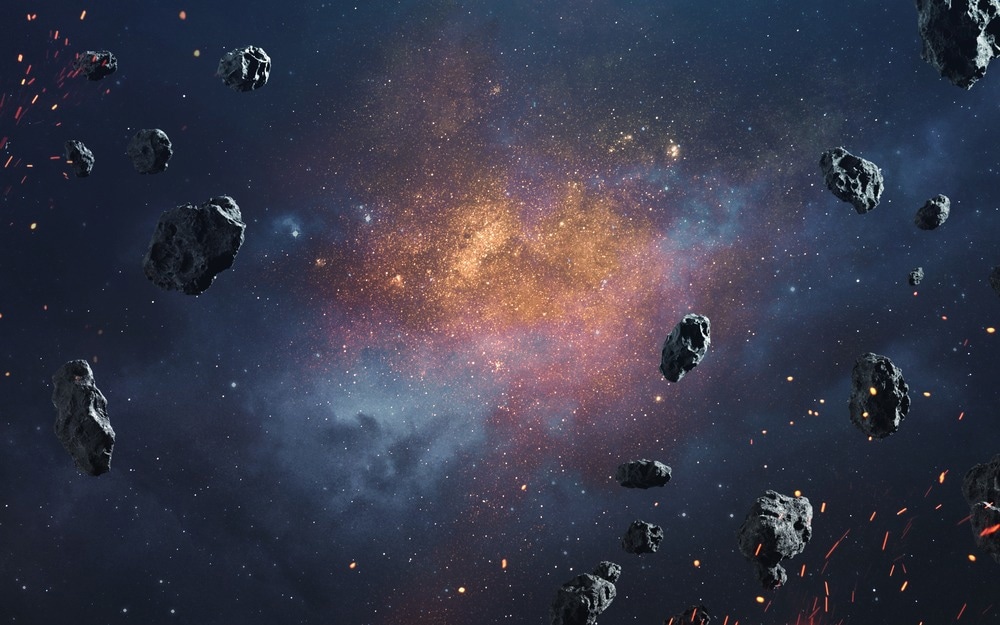The next era of space exploration will involve longer missions and sustainability. But the drive for sustainability here on Earth could lead to commercial asteroid mining.

Image Credit: Vadim Sadovski/Shutterstock.com
As the negative effects of our human activity and industry on the environment become increasingly clear and resources continue to deplete, researchers are increasingly finding sustainable practices, particularly those that can reuse materials.
However, there is another possible answer to Earth’s depletion of resources. What if we could mine those substances elsewhere? Mining asteroids is one potential solution suggested by scientists.
The Potential of Mining Asteroids
Asteroids are potential candidates for off-world mining operations as they are composed of the primordial material left over from the formation of the solar system 4.6 billion years ago.
This material, which escaped being dragged into the planets as they formed, exists in a pure unpolluted state, making asteroids a prime target for researchers investigating the origins and evolution of the solar system.
It also means they are made of the same materials we find on Earth — sometimes in great abundance. Materials that can be mined and used on Earth.
This has led to the launch of several asteroid mining companies, including Planetary Resources, a Seattle-based aerospace company that hopes to extract water ice and resources from asteroids. Also involved in this chase is Deep Space Industries.
These companies have designed satellites that have so far identified around 15,000 asteroids that could be mined.
Operations to return material from asteroids are already underway, albeit on a much smaller scale than mining these space rocks would require.
One of the key elements currently holding back the mining of asteroids is the difficulty in making such projects cost-effective.
Can Asteroid Mining Be Cost-Effective?
As an example of the possible value of asteroid mining, Statista¹ estimates the value of the asteroid Ryugu — a diamond near-Earth asteroid (NEA) that is estimated to be 900 meters in diameter — at 82.8 billion dollars (USD).
Statista also estimates that even with the costs of flying a mission to Ryugu, the profit for raw materials that could be returned is still in the region of 30 billion (USD).
Not all asteroids are this valuable. Statista gives the value of materials that could be mined from Bennu as 0.67 billion (USD). According to Harvard³, NASA’s OSIRIS-REx mission is projected to cost over 1 billion USD and will take seven years to return between just 400 grams and 1 kilogram of material to Earth.
Mining asteroids is a big leap from sample collection missions to mining resources from asteroids, but some commercial entities are already making the first tentative steps to reach this goal. Cost-effectiveness is at the forefront of these operations.
Asterank⁴ is a scientific and economic database of more than 600,000 asteroids. By collecting and computing important data such as asteroid mass and composition from multiple scientific sources, the resource has estimated the costs and rewards of mining asteroids. This includes determining the top 10 most cost-effective asteroids with the two most important qualities being proximity to Earth and greatest in value. Mining these asteroids alone, Harvard would result in a profit of 1.5 trillion USD.
Asteroid Psyche: A Potential Orbiting Gold Mine
One of the most intriguing occupants of the main asteroid belt — located between Mars and Jupiter where most asteroids dwell - is Psyche.
This giant asteroid with a diameter of around 140 miles — 1/16 of the diameter of Earth — is believed to be the core of a shattered planetesimal that never grew to planet status.
In addition to being a prime scientific target, the potato-shaped Psyche could also be a huge economic opportunity. The asteroid is theorized to contain 700 quintillion USD worth of gold. Harvard states that this is enough for every person on Earth to obtain 93 billion USD.
The Negatives of Asteroid Mining
While the effects asteroid mining would have on the environment, even if simply by halting mining operations, which can discharge toxic chemicals such as lead and arsenic into waterways and contribute to acid mine drainage, would be positive, there is a potential downside.
The question is, what effect would flooding the market of Earth with an abundance of materials from space have on the global economy? The primary result would be the devaluation of the global raw material industry, which Insider⁵ values at $660 billion USD per year.
In a 2018 study⁶ published in Acta Astronautica, researchers from Tel Aviv University, Israel, simulated the effects of flooding the market with space-recovered material.
They found that just one shipment of minerals from asteroids halved the price of gold.
Regardless of the potential risks, companies such as Planetary Resources and Deep Space Industries will continue in their attempts to make asteroid mining a reality.
References and Further Reading
¹ Asteroid mining value and profit estimates for most cost-effective asteroids, Statista, [2022] https://www.statista.com/statistics/656590/cost-effective-asteroid-mining-value-and-profit-estimates/
² Asteroid Explorer Hayabusa2
³ Economics of the Stars: The Future of Asteroid Mining and the Global Economy, Havard International Review, [2022] https://hir.harvard.edu/economics-of-the-stars.
⁴ Asterank, [accessed 06/22/22], https://www.asterank.com/
⁵ Desjardins. J., [2016], “There’s big money to be made in asteroid mining,” Insider, https://www.businessinsider.com/the-value-of-asteroid-mining-2016-11?r=US&IR=T
⁶ Paikowsky. D., Tzezana. R., [2018], “The politics of space mining — An account of a simulation game,” Acta Astronautica, https://doi.org/10.1016/j.actaastro.2017.10.016
Disclaimer: The views expressed here are those of the author expressed in their private capacity and do not necessarily represent the views of AZoM.com Limited T/A AZoNetwork the owner and operator of this website. This disclaimer forms part of the Terms and conditions of use of this website.